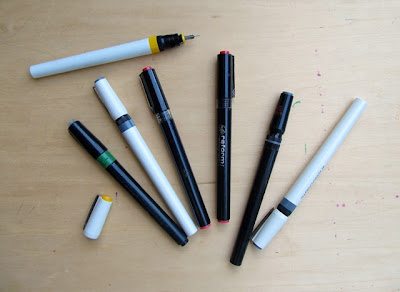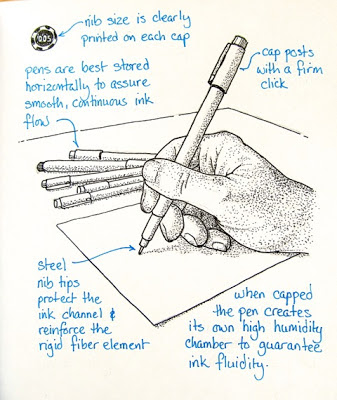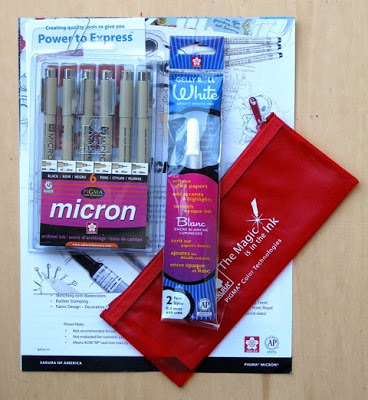cherry blossom trees were presented as a friendship gift to the American
people from the people of Japan in 1912
people from the people of Japan in 1912
The stylographic pen was the first successful self-feeding pen in history and is still with us today (think tech pens). The cherry blossom is an iconic symbol of Japanese culture: representing purity and simplicity, and celebrated in art, song, and annual festivities. (It has even spread to North America, where the United States celebrated the centennial of the Washington, DC, Cherry Blossom Festival this year.) What is the connection between the two? Read on.... ;-)
Ever since mankind first began writing with feather quills and ink there have been technically-minded folk who have worked diligently to develop new technologies that made pens more reliable, more versatile, and more resilient.
a range of vintage and new stylographic technical pens - very
little has changed over the past 40 years
little has changed over the past 40 years
In 1803 cutting edge technology allowed British manufacturers to introduce steel nibs that easily outlasted the older, more labor-intensive feather quill. And, for the next century, Great Britain was the source of arguably the best nibs in the world. But there were still major shortcomings of the pen; it ran out of ink quickly and had to be re-dipped, and if you were traveling there was always the threat of a messy ink spill. The search for a pen with a built-in ink reservoir was on.
Microns are equally adept at line work and stippling
Enter in 1875 Duncan MacKinnon, a Canadian pharmacist and the inventor of the world's first successful stylographic pen, a pen type that offered two very remarkable technical developments: a built-in ink reservoir; and a tubular "nib" that produces an amazingly thin, uniform line -- perfect for technical drawing and fine writing. The stylographic pen not only predated the fountain pen by some 10 years, it also offered (and continues to offer) one major advantage over the latter; it could use waterproof ink! But there was room for technical improvement.
Pigma ink is fast-drying and completely waterproof -- perfect
for working with bright watercolor washes
for working with bright watercolor washes
In 1877 the American A. T. Cross (founder of the Cross pen company) received a patent on an improved, spring-loaded feed. And in 1910 the Sanford & Bennett company patented the rugged "gravity feed" system that has been the unchallenged standard design for "tech pens" ever since -- or at least it was until the 1980s.
without a need for set-up or clean-up more time can be focused on the subject
Technical/stylographic pens have one flaw; their amazingly fine tubular tip or "nib" is subject to blockage if the ink congeals or dries out and then requires a complete disassembly and cleaning. (To this date all Rapidograph tech pens are sold with a wheel-shaped wrench for disassembling the nib section.)
rapid drying time means that Pigma works well with a wide range of
paper types while feathering and bleed-through are minimized
Then, in 1982 a small Japanese firm called Sakura Color Technologies (Sakura means "Cherry Blossoms" in Japanese) came up with a brilliant idea: combine the fine steel tubular nib of the stylographic pen with a rigid, highly refined version of the fiber tip pen, and introduce a nano-particle pigment ink that is pH neutral, waterproof, lightfast, and archival. The result was the Sakura Pigma Micron pen, which revolutionized not only in-studio technical drawing but also field work, nature sketching, and travel journaling. (I have found them so reliable personally that they were the only pens I chose to carry during my 8-week sketch crawl of Europe, and I had the extreme good fortune to enjoy their sponsorship during my 10-week wilderness adventure in the North Cascades mountains.)
the Micron is equally well suited to image making or note taking
the Micron's larger ink reservoir means no need for refills,
even during the most detailed project
Of course, the steel- or gold-nibbed fountain pen is far from dead. (I, for one, absolutely love it's creative potential.) But for ease of use, unmatched reliability, and the way it works in combination with watercolors, the Sakura Micron is an artist's dream.
Technical Notes: I had a fascinating telephone conversation with Peter Ouyang (Sakura of America's Vice President for Marketing and Product Development) and learned some very interesting technical details about Microns. For instance, while the pen comes with a pocket clip this is intended as a temporary means of "carry." Mr. Ouyang informed me that the pigment particles in the ink are subject to the effects of gravity and, therefore, the ink will actually drain from the tip if stored vertically. It is best to keep the pens capped and horizontal when not in use. Mr. Ouyang also told me of a little "trick" if one's pen seems to run dry; first recap the pen immediately (this created a micro-climate that promotes a moist environment) and then set the pen cap-down in an empty cup overnight. If there is still ink in the reservoir gravity will feed it back into the tip and the pen will write good as new in the morning. Interestingly, Mr. Ouyang informed me that Sakura actually adjusts the fineness of the pigment particle grind for each nib size -- the finer the tip, the finer the grind -- and, because of the specific nature of each pigment, there is sometimes a limit to how fine a nib certain pigments will flow through properly.
Historical Notes: The Micron isn't Sakura's only claim to technical fame. In 1925 the company created the world's first oil pastels -- a new medium that Pablo Picasso soon fell in love with and, as they say, the rest is history. And Sakura has not been satisfied to rest on their much deserved laurels. In 1984 Sakura produced the world's first gel inks and continues to be an art materials innovator right into the 21st century.
_____________________________________________
Second Grand Prize Giveaway: Since this is my second giveaway I figured it only right to have two prizes, and the folks at Sakura of America have generously provided some wonderful gifts. The first prize will be a new set of 6 Pigma Micron black ink pens in sizes .20mm to .50mm AND one Gelly Roll opaque white pen AND a red Sakura pen carry!
first prize
The second prize will be a set of 6 Pigma Micron basic color pens AND one Gelly Roll opaque white pen AND a red Sakura pen carry!
second prize
The Entry Rules: I'll keep these simple: 1) Click on the blue "Join this site" button under "Followers" in the right side bar (if you've joined previously, you've already completed step one); 2) leave a comment (do NOT include your contact information) for this posting any time between now and Friday, November 2; 3) two winners will be drawn at random and contacted via PM on Saturday, November 3. Winners will also be announced here on Monday, November 5.
Good luck!












Thank you for the tip for possibly re-activating dry pens. I want to use every last bit of ink. Thank you for the chance to win!
ReplyDeleteYes!! Yes!!! I would love to try these pens! I let my 5 year old borrow a nice pen of mine last week and his sentiments were so exciting, "Mama, I love this pen. It makes me feel like I can write something really important!" Oh yes, little man, indeed you can. Thanks for the chance to win!
ReplyDeleteI followed. :D Thanks for the great giveaway! ;D
ReplyDeleteFirst of all, thanks for the great information!
ReplyDeleteMicrons have always been my 'go to' pens even after trying lots of others.
Would love to have more.
Lots of great info in your post. It's always nice to have some fresh Microns on hand.
ReplyDeleteThank you for the giveaway ;)
ReplyDeleteThanks for the opportunity to win some great pens!
ReplyDeleteI love your sketches, an 8 week sketch crawl in Europe sounds like heaven!
Great information on the pens too thanks :)
Interesting read, Earnest! My personal favourite Sakura product is the Koi Watercolour field kit, which I would take if only allowed ONE supply...Thank you for the Giveaway!
ReplyDeleteWhat an informative post, Earnest. As you know, I'm a fountain pen sketcher but I love the Sakura Micron pens...when they're new. I gave up on them, though, because they were "running out" of ink far too quickly to justify my continued purchase of replacements. But maybe they're not running out at all. Will have to give them another try.
ReplyDeleteI love your review style. Great drawings!! Ahh I dream of being able to create like this one day! :) Thank you for the chance to win as well! I'm a new follower but very happy to be one :)
ReplyDeleteAn incredible blend of art and information. Thank you for a very interesting read!
ReplyDeleteWhat great information, Earnest! I love reading your posts and always learn something. That's a great tip about the microns.
ReplyDeleteLeslie
Wow I really love Pigma Micron pens. No wonder they don't dry out even if I haven't used them for a while! Thanks for this post!
ReplyDeleteI love your articles and love your examples!!!! Your articles are so informative!!
ReplyDeleteI really enjoy your posts, reviews, and art style. Thanks for your posts!
ReplyDeleteVery interesting article and I love Pigma Micron pens!
ReplyDeleteWonderful article, love your art and thank you for the giveaway. I'm a fountain pen person also.
ReplyDeleteWhat and interesting and usefull info Earnest, since I started to sketch I´ve been wanted to try Sakura´s products, who knows.
ReplyDeleteRegardas to all.
I am saving this post in 'Google Reader' (where I'm subscribed) because it has so much great information I want to come back and read it again. Also so lovely of you to offer a contest, and Sakura to provide so generous. Exciting for us all to see who wins the goodies. Thank you for your terrific blog, Earnest, as others have said you share wonderful information and inspiration.
ReplyDeleteMy interest in art (beyond the crayon stage) was piqued when my high school art teacher introduced me to the "pen and ink" medium. Two or three projects into the class and I was hooked. The concepts have remained little changed but wow what a difference in the delivery system!
ReplyDeleteBeautiful work! I use Sakura pens for doodling and love them. I have white gelly roll pen and have yet to actually use it. I enjoyed the history of pens you wrote. I have a lovely Scheaffers bakelit fountain pen from the 1960's that I would kill someone for stealing or breaking.
ReplyDeleteEarnest your work is in a class by itself... always! BUT that sketch with the phone booth... it's like an illustration from the days of old when sketches were the norm in publications. LOVE it!
ReplyDeleteAs a quilter, I use Sakura pens to write on fabric for permanent labels. The labels last through multiple launderings, so future generations (I hope!) will know who made my quilts...
ReplyDeleteI love your work, I really do...but I'm most grateful for the way it makes me view this ol' world a little differently.
ReplyDeleteGreat article with good technical information! Thank you!!
ReplyDelete